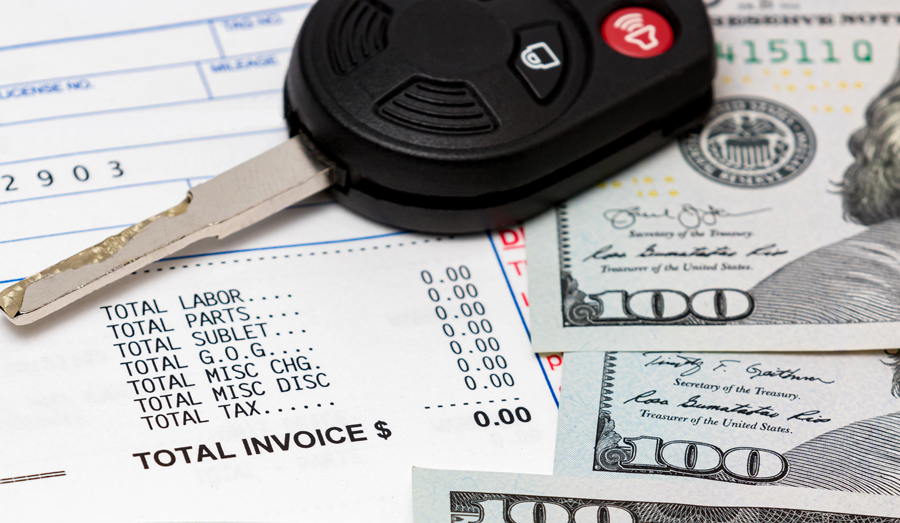BY CHRIS PRZYBYLSKI
After working with hundreds of transportation companies to customize their fleet programs, there are certain steps we’ve identified that can help businesses of any size to optimize one of their most expensive assets: their vehicles. If executed properly, an effective fleet management program will help your operation run more efficiently and, best of all, save you money—even if you have a small fleet.
 1. Reduce Repair Costs
1. Reduce Repair Costs
One of the key advantages of preventive maintenance in fleet management is the ability to address small, seemingly minor issues before they escalate into major ones. For example, take the case of a small oil leak. When detected and repaired through routine checks, it might only require a simple seal or even a new filter. However, if unnoticed, this tiny leak can lead to severe engine damage. Repairing or replacing a damaged engine is obviously significantly expensive and creates extensive downtime. Similar savings can be seen with rotating tires and identifying suspension issues early. Tires are a major cost and proper maintenance can lower this line item dramatically. And don’t forget about that chip in your windshield: It easily becomes a crack, which costs 10 times as much to replace.
With these examples, the cost-effectiveness of preventive maintenance becomes evident. Having your mechanic conduct regular preventative maintenance not only extends the life of the vehicle but gives them a chance to catch minor issues that would otherwise go unreported.
2. Reduce Downtime
Whether it’s the lost revenue of not being able to do the job or the added expense of contracting out a vehicle, downtime costs money. By following a regular preventative maintenance schedule, issues can be identified and repaired whenever it is most convenient for your business. Imagine not waiting on major parts or for a specialty vendor. Most preventative issues can be identified by your mechanics or local shop and quickly repaired. If something major is identified, the part can often be ordered before it’s needed, so that you can replace it before the breakdown occurs. For large fleets, this means keeping fewer spare vehicles and the costs related to them.
“... over half of all vehicle-caused accidents could be prevented with a strong preventative maintenance program.”3. Fuel Savings
According to fueleconomy.gov, improperly inflated tires reduce fuel efficiency an average of .6 percent. While this may not seem like much, this can ultimately cost hundreds of dollars per year on small vehicles and thousands on the larger ones. Another area of easy savings is simply using the proper oil for your engine. Replacing your oil regularly increases fuel efficiency by as much as 1-2 percent. Without even getting into areas of contention like reduced idling and route planning, you can easily reduce your fuel costs by 1.5 percent by conducting proper preventive maintenance.
4. Insurance
Insurance rates continue to rise due to costly accidents around the country, not to mention the costs associated with repairing modern vehicles. As your agent can no doubt tell you, it’s your job to convince the insurance company that you’re a safe risk. One of the easiest ways to do this is with comprehensive maintenance files. In a study done by NHTSA, of the 44,000 accidents caused by vehicle issues, 35 percent of these were caused by tires and 22 percent were caused by brakes. By checking both every time you do preventative maintenance (and, of course, document it), you could reduce your vehicle risk by 57 percent.
5. Accident Prevention
Accidents don’t just drive insurance costs up, they also cause downtime, generate poor reviews and negative media, and can even put you out of business in the most extreme cases. As we discussed, over half of all vehicle-caused accidents could be prevented with a strong preventative maintenance program. Implement other common fleet management and safety techniques like speed tracking and/or camera units to reduce this risk even more.
 6. Data-Driven Decisions
6. Data-Driven Decisions I don’t have to tell you that fleet costs are a major line item for transportation companies. The only way to maximize profits is to understand these costs and use proper data to make your decisions. A fleet software program like the one offered by LBC Fleet can help you identify your cost per mile, vehicle utilization, life cycle, and average repair costs. This data should then be used to determine vendor negotiations, replacement schedules, and even your rates to the customer. Having this information readily available will help you make better decisions for your operations and bottom line.
7. Fewer Customer Complaints
For the average passenger carrier, about 25 percent of all customer complaints are related to vehicle problems. Nearly all these issues are preventable. Conducting full vehicle inspections during each preventative maintenance cycle lets you identify not only mechanical issues, but also any issues with comfort items. Use this time to check for broken seats, USB ports, microphones, reading lights, arm rests, etc., to increase customer satisfaction. In addition, fewer mechanical breakdowns simply means fewer bad reviews and customer refunds while protecting your reputation as a safe and reliable company.
“Providing documented maintenance records can raise the resale value of your used fleet vehicles by up to 15 percent.”8. Inventory Costs
An often-overlooked component of fleet management is parts inventory. Maintaining the right level of parts is critical to prevent delays in servicing vehicles, but carrying too many puts a financial burden on the company and can make it difficult to locate the necessary items when needed. It may seem smart to stockpile certain parts, but only if they’re regularly used and are easily accessible. A proper fleet management system not only compares parts costs, but also tracks what is being used and how often. By knowing your needs, you can set inventory levels that keep your fleet department running smoothly.
9. Vehicle Value
Providing documented maintenance records can raise the resale value of your used fleet vehicles by up to 15 percent. Increasing the cash value of the fleet also boosts the overall value of the business and allows you to choose when to replace your metal. Using data-driven fleet management, you can determine when to sell a vehicle to maximize its resale while minimizing the likelihood of major repairs. Figuring out the sweet spot for replacement lowers costs and ensures your fleet is always set up for peak profitability.
10. Vehicle Selection The same data-driven decision making that determines when to replace a vehicle can help you choose what to buy next. What costs more for you to operate over the years, an Expedition or an Escalade, an MCI or a Prevost? What is the life expectancy of each? Average downtime? Proper fleet management records and analysis lets you choose the right vehicles for your fleet to maximize profitability and lower lifetime costs of ownership.
With all the time, money, and effort you invest into your metal, having a comprehensive fleet management program will produce the best ROI and even help identify areas where you can lower your overall operational costs by tracking trends and spotting problems before they become major issues. A good plan can also ensure that you are charging the correct rates for your service or uncover those vehicles that are costing you too much and weighing down profitability. If you’re not currently taking advantage of all that a fleet management plan has to offer, then it should be on your 2024 to-do list. [CD0124]
Chris Przybylski is the co-founder of LBC Fleet. HE can be reached at chris@lbcfleet.com.

